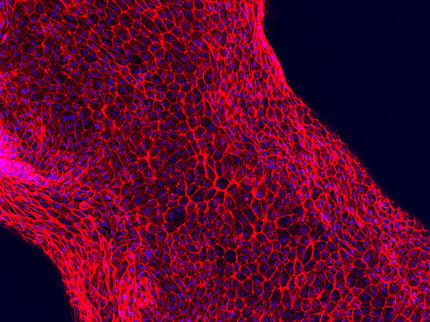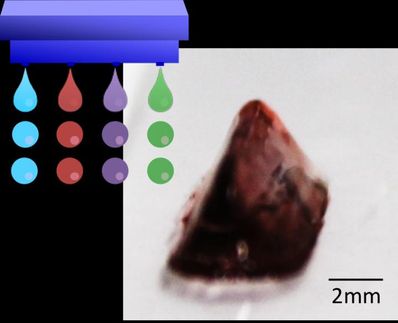Replacement for animal testing - now completely without animal suffering
First tissue model of the liver produced entirely without materials of animal origin
Advertisement
Scientists at TU Berlin have used 3D bioprinting to produce a model of the liver from human cells for the first time without having to resort to materials of animal origin. This success is an important step towards biomedical research and teaching that is based entirely on methods without animal suffering. Until now, replacement methods for animal experiments have also used nutrient solutions obtained from the fetuses of calves, for example. And for the 3D printing of organ models, among other things, structure-forming substances have so far been required that come from tumors grown in mice. In addition to these ethical aspects, biomedical research without any animal components also improves the transferability of its results to humans - which gives hope for faster success in the development of drugs.

Scientists at the bioprinter
Felix Noak
"In Germany, it is actually forbidden to slaughter pregnant cows," explains Prof. Dr. Jens Kurreck, Head of the Department of Applied Biochemistry at TU Berlin. If a pregnancy is not recognized before slaughter, it is common practice to take blood from the foetus. This is because it contains many substances that stimulate growth and are therefore ideally suited for the multiplication of cells in biological research. The "fetal calf serum" obtained from the blood is a standard product in every cell culture laboratory.
Probably more than two million calf fetuses per year
"There are only rough estimates of the number of calf fetuses required for this. A publication from 2021 assumes two million worldwide, and since then the consumption of foetal calf serum has tended to increase," says Kurreck. A large proportion of this comes from slaughtering in non-EU countries and is therefore difficult to monitor by German or European institutions. "Because calf serum is so suitable for cultivating cells, it is naturally also used by researchers who want to replace animal experiments with the help of cell cultures. Until recently, that included us."
Mice with tumors of a fifth of their body weight
Because Jens Kurreck's working group uses 3D bioprinting, a particularly promising method for producing organ models to replace animal testing, the scientists have so far also had to rely on a second animal product, which is obtained from animals bred specifically for this purpose. "With the help of 3D printing, we can produce small, three-dimensional organ models from human cells that can even contain artificial blood vessels. To do this, however, we need substances such as laminins and collagens, which give these structures the necessary firmer structure than is the case with normal cell cultures," explains the researcher. They are found in high concentrations in a special form of the so-called extracellular matrix, which surrounds the cells in the body of humans and animals like a mesh and mediates contact between them.
This substance, abbreviated BME (for "Basement Membrane Extract"), is obtained from tumors that are grown in mice. "In the end, such a tumor weighs about four grams, with a mouse body weight of perhaps twenty grams. This ratio alone shows that this procedure has a not inconsiderable adverse effect on the animal." Because the structure-promoting substances from the BME are also routinely used in other cell culture laboratories for various applications, the number of animals used for production would certainly be in the thousands, says Jens Kurreck.
Animal components make research less reliable
Human cells that are nourished and stimulated to multiply with the help of blood serum from calves, from which human organ models are then printed with the help of structure-promoting substances from mouse tumors: "If you think about these production steps, you can already see that there is potential for errors if you want to draw conclusions about the actual processes in the human body from experiments with these organ models," explains Kurreck. And in principle, the organ models from human cells are already much more predictive than corresponding animal experiments when it comes to the same question. For example, human tumor cells are also introduced into animals. However, these human cells are still located in animal tissue as an environment and also communicate with these animal cells, which makes it very difficult to transfer the findings to humans.
In addition, according to Kurreck, the exact composition of animal products such as foetal calf serum always varies. It is therefore not possible to rely on one batch, for example, stimulating cell growth in the same way as another. "90 percent of all promising candidates for drugs in the laboratory and in animal experiments and even 97 percent of all candidates for cancer drugs ultimately fail when tested on humans. If we want to improve in this area, the goal must be to eventually do without animal testing and without any animal additives or excipients."
Chemically precisely defined culture media and structural substances from human sources
PhD student Ahmed Ali and other members of Jens Kurreck's working group have now taken a major step in this direction with the first tissue model of the liver completely without materials of animal origin. They have replaced the fetal calf serum with a chemically precisely defined culture medium consisting of growth factors, insulin, selenium, sugars and salts. "Not only did we have to adapt this culture medium to the specific type of human liver cells we were using, we also had to acclimatize the cells to the new environment in a slow process," explains Kurreck. The initial cells for the start of the experiment were of course supplied by a company that had used calf serum for their propagation.
As a substitute for the structure-promoting mixture BME from the mouse tumors, the scientists used human collagen from placentas that would otherwise have been disposed of as waste in Viennese hospitals after births. "What sounds so simple was in practice a complex adaptation process that required a lot of trial and error as well as extensive literature research," says Jens Kurreck. For example, the plastic dishes in which the cells were cultivated had to be specially coated with human collagen from the placentas in order to achieve a similarly good adhesion as with the conventional method.
Test results confirm the equivalence of the cruelty-free method
To test their new, cruelty-free liver model, the researchers brought it into contact with the toxin okadaic acid, which is produced by algae, accumulates in mussels and can lead to severe fish poisoning. It was found that two-dimensional printed structures of the cells showed the same sensitivity to the toxin, regardless of whether they had been grown and printed with the old or the new substances without animal origin. A three-dimensional tissue model of the liver also showed the sensitivity expected by the researchers for this case.
Transfer into practice through an interdisciplinary approach
The scientists involved are optimistic that their new, cruelty-free method will not only quickly find its way into practice, but will also be widely used. Albert Braeuning from the Federal Institute for Risk Assessment (BfR), the national authority for food safety, was not the only potential user of the method to be directly involved in the current publication. Prof. Dr. Cornelia Rauh's Department of Food Biotechnology and Process Engineering at TU Berlin also contributed to the study by measuring the mechanical parameters of the new 3D bioprinting ink. Together with Jens Kurreck's working group, the scientists there are also researching cultured meat for human consumption, for which cultivation methods without fetal calf serum are also required. Future optimization of the animal-free method is being sought in collaboration with the Department of Bioprocess Engineering at TU Berlin led by Prof. Dr. Peter Neubauer. In the future, human collagens could possibly be produced in the required quantities from yeast cells - or even directly from human cell cultures in the more distant future.
Note: This article has been translated using a computer system without human intervention. LUMITOS offers these automatic translations to present a wider range of current news. Since this article has been translated with automatic translation, it is possible that it contains errors in vocabulary, syntax or grammar. The original article in German can be found here.


















































